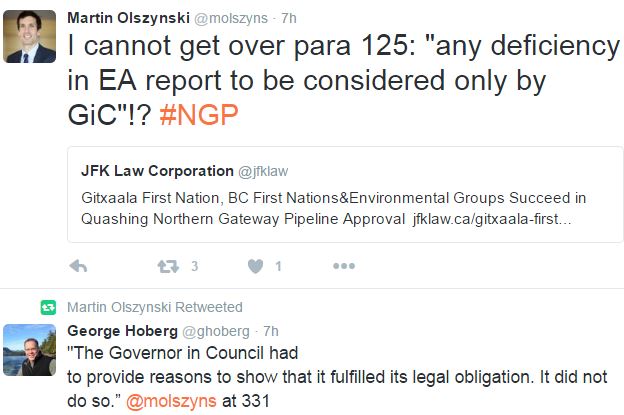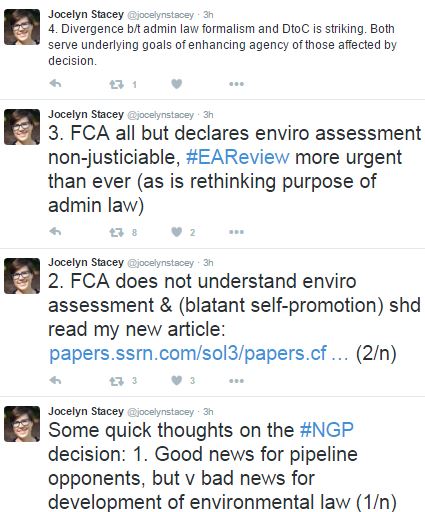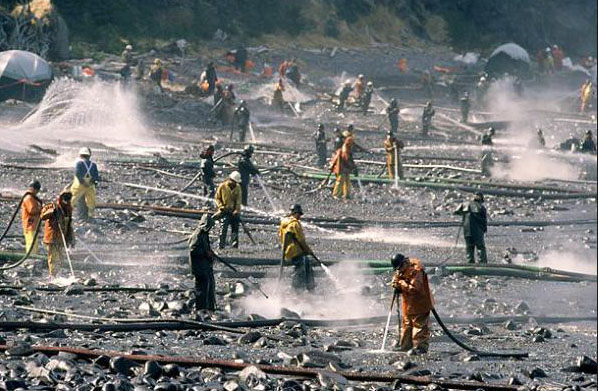
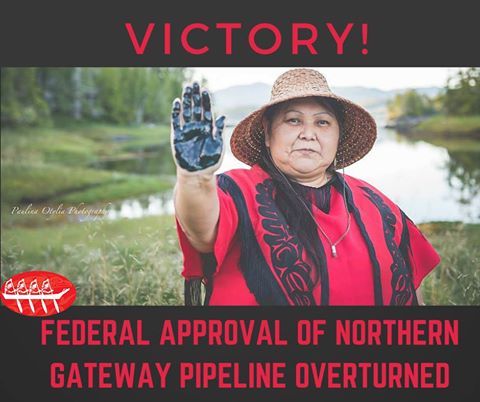
Notable paragraphs from the ruling with some snaps of valuable comments on Twitter:
[125] In the matter before us, several parties brought applications for judicial review against the Report of the Joint Review Panel. Within this legislative scheme, those applications for judicial review did not lie. No decisions about legal or practical interests had been made. Under this legislative scheme, as set out above, any deficiency in the Report of the Joint Review Panel was to be considered only by the Governor in Council, not this Court. It follows that these applications for judicial review should be dismissed.
[Paper referred to in point 2. above:
The Environmental, Democratic, and Rule-of-Law Implications of Harper’s Environmental Assessment Legacy 18 pages by Jocelyn Stacey, University of British Columbia (UBC), Faculty of Law, June 23, 2016
Review of Constitutional Studies, 2016
Abstract:
The article argues that Harper’s dramatic changes to federal environmental assessment give rise to a two-dimensional legacy in environmental law: first, a legacy of impoverished environmental decision-making that reflects a narrow, resource-oriented vision of the environment, and second, a legacy of undermining democratic and rule-of-law values in environmental law. The crux of this latter legacy is the argument that environmental assessment law provides an essential framework for publicly-justified decision-making in the Canadian environmental context. Indeed, as I suggest in this article, environmental assessment presently performs a quasi-constitutional role in Canadian environmental decision-making in the sense that it provides the means by which the federal government fulfills its constitutional obligation to govern the environment in accordance with the rule of law.]
[279] Based on our view of the totality of the evidence, we are satisfied that Canada failed in Phase IV to engage, dialogue and grapple with the concerns expressed to it in good faith by all of the applicant/appellant First Nations. Missing was any indication of an intention to amend or supplement the conditions imposed by the Joint Review Panel, to correct any errors or omissions in its Report, or to provide meaningful feedback in response to the material concerns raised. Missing was a real and sustained effort to pursue meaningful two-way dialogue. Missing was someone from Canada’s side empowered to do more than take notes, someone able to respond meaningfully at some point.
[324] Had the Phase IV consultation process been adequate, had the reasons given by Canada’s officials during the consultation process been adequate and had the Order in Council referred to and adopted, even generically, that process and the reasons given in it, the reasons requirement might have been met. But that is not what happened. Here too, Canada fell short of the mark. [Emphasis added]
Court quashes Enbridge pipeline, slams Harper government for ignoring First Nations by Mike De Souza, June 30th 2016, National Observer
In a stinging repudiation of former prime minister Stephen Harper’s treatment of Canada’s First Nations, the Federal Court of Appeal has asked the government to reconsider a 2014 decision to approve a major pipeline project to the west coast of British Columbia.
… The controversial multibillion dollar project was approved by Harper’s government in June 2014, following a lengthy review, with more than 209 conditions. But Alberta-based Enbridge has not yet been able to get the project started and the court decision blamed Harper’s government for messing up the environmental assessment.
The court decision, which could be appealed, makes it unlikely that the project can proceed without meaningful consultation with affected first nations, but not impossible.
If built, the project would ship bitumen from Alberta’s oilsands region to Kitimat on the west coast of British Columbia, enabling new exports of Canadian oil to Asia. The project would also include a separate pipeline for a toxic mixture used in the oil pipeline to help the heavy tar-like bitumen flow.
While Enbridge and supporters from the business community have backed the project describing it as a job-creating path to prosperity, many First Nations have joined forces with politicians and environmentalists in opposition to the project because of the risks of an oil spill and the climate-warming greenhouse gases associated with the project and expansion of the oilsands industry. Enbridge has 31 First Nations and Métis partners in its bid to build Northern Gateway.
Orders from “highest level” of Harper’s government
In their ruling, the judges from the appeal court said Harper’s government rushed the consultation process, with orders from the “highest level of government” directing that information of federal knowledge about the harmful impacts of the project “not be shared with any First Nation.”
“The inadequacies—more than just a handful and more than mere imperfections—left entire subjects of central interest to the affected First Nations, sometimes subjects affecting their subsistence and well-being, entirely ignored,” said the June 23 court decision that was publicly released on Thursday. “Many impacts of the project… were left undisclosed, undiscussed and unconsidered. It would have taken Canada little time and little organizational effort to engage in meaningful dialogue on these and other subjects of prime importance to Aboriginal peoples. But this did not happen.”
The court also found that the government could have resolved the issue, simply by extending consultations by about four months.
“But in the face of the requests of affected First Nations for more time, there was silence,” said the ruling. “As best as we can tell from the record, these requests were never conveyed to the Governor in Council, let alone considered.”
Canada’s energy regulator, the National Energy Board – which ultimately was the organization that recommended that the project be approved, noted in a statement to National Observer that the ruling had praised the assessment process for being set up well and that this was no small achievement. But the regulator also said it was too early to say if it would appeal the decision, adding that Prime Minister Justin Trudeau’s cabinet would also need to weigh in about the future of the project.
The Liberals had campaigned against Northern Gateway, during the last election and were critical of Harper’s treatment of Indigenous communities. Shortly after the ruling was made public, Natural Resources Minister Jim Carr said through a spokesman on Thursday that the government would review the ruling before deciding what to do next.
“The government of Canada is committed to a renewed, nation-to-nation relationship with Indigenous peoples, based on recognition of rights, respect, cooperation and partnership, including our duty to consult,” said Carr’s spokesman Alexandre Deslongchamps.
“We are working to restore public confidence in the credibility of environmental assessments ensuring decisions are based on science, facts and evidence, including the traditional knowledge of Indigenous Peoples.”
The ruling was also critical of the former Harper government for failing “to engage, dialogue and grapple with the concerns expressed to it in good faith” by all of the affected First Nations.
“Missing was any indication of an intention to amend or supplement the conditions imposed by the (review panel), to correct any errors or omissions in its Report, or to provide meaningful feedback in response to the material concerns raised,” said the ruling. “Missing was a real and sustained effort to pursue meaningful two-way dialogue. Missing was someone from Canada’s side empowered to do more than take notes, someone able to respond meaningfully at some point.”
The ruling also singled out former Conservative environment minister Peter Kent for committing in an April 2012 letter to meaningful dialogue. The government would then avoid “defining exactly what was in play during the consultations,” the court said.
The court noted that, Jim Clarke, a senior government official in charge of overseeing major project reviews had confirmed in testimony that consultation on several issues “fell well short of the mark.”
Enbridge remains committed to building Northern Gateway
In a statement, Enbridge said that the ruling “addressed important concerns” but it remained committed to building the new pipeline.
“Though the court found that the (review panel’s) recommendation was acceptable and defensible on the facts and the law and is reasonable, they concluded that further consultation is required,” Enbridge spokesman Graham White told National Observer in the statement. “While the matter is remitted to the federal government for their redetermination, Northern Gateway will consult with the Aboriginal Equity Partners and our commercial project proponents to determine our next steps.
[Legal Cross Check:
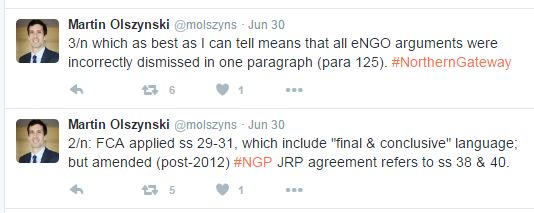
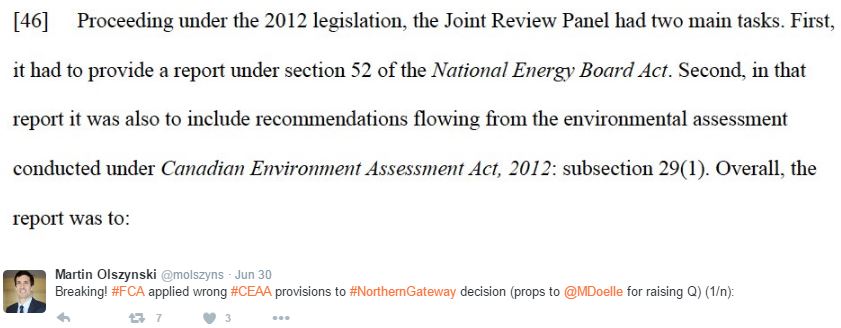
“However, the Aboriginal Equity Partners and our commercial project proponents are fully committed to building this critical Canadian infrastructure project while at the same time protecting the environment and the traditional way of life of First Nations and Métis peoples and communities along the project route.”
First Nations who make up the Yinka Dene Alliance were in a celebratory mood after reading the ruling.
“Yinka Dene Alliance First Nations refused Northern Gateway permission to enter our territories as a matter of our own laws, and now the Court has made it crystal clear that the government must listen to us and take our laws seriously,” said Chief Larry Nooski of Nadleh Whut’en First Nation in a statement.
Stand, one of the environmental groups involved in the case under its previous name – ForestEthics Advocacy Association – was also celebrating the news, saying that it indicates the pipeline won’t be built.
“I think it’s a great day for the people, it’s a great day for the climate and it shows what people have been saying along on,” said Karen Mahon, a veteran activist with Stand. “It’s a repudiation of the way the Harper government dealt with Indigenous people”
Editor’s note: This article was updated at 6 p.m. ET on Thursday to include reaction from the federal government and the National Energy Board. [Emphasis added]
Northern Gateway pipeline proposal stymied after court quashes approval by Geordon Omand, The Canadian Press, June 30, 2016, Edmonton Journal
A pipeline proposal more than a decade in the making has suffered a major setback after a court revoked the federal government’s approval for the project to link Alberta’s oilsands to British Columbia’s north coast, saying Ottawa failed in its duty to consult with aboriginal people.
In a [2-1] split decision released Thursday, the Federal Court of Appeal quashed approval for Enbridge’s $7.9-billion Northern Gateway project.
The judgment says the government neglected to discuss subjects of critical importance to First Nations by ignoring many of the project’s impacts and offering only a “brief, hurried and inadequate” opportunity for consultation.
“The inadequacies — more than just a handful and more than mere imperfections — left entire subjects of central interest to the affected First Nations, sometimes subjects affecting their subsistence and well-being, entirely ignored. Many impacts of the project … were left undisclosed, undiscussed and unconsidered,” the decision reads. [Under Harper approval, is that a surprise?]
“It would have taken Canada little time and little organizational effort to engage in meaningful dialogue on these and other subjects of prime importance to Aboriginal Peoples. But this did not happen.”
[Refer to Enbridge’s Kalamazoo dillbit spill in Michigan, 6 years later, still not adequately cleaned up:


Image by Line 9 Communities: Workers Examining Line 6B Rupture in Ground
Source: NTSB Michigan Spill Report
Photo Jack McNeary.com
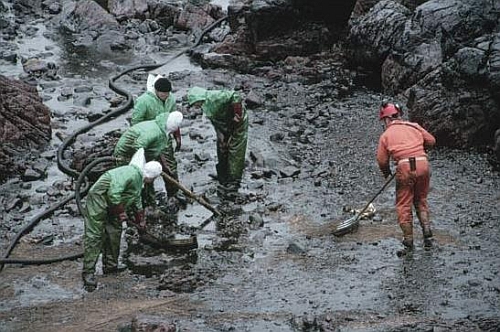
Enbridge Energy’s 2010 Kalamazoo River Oil Spill: Worst Pipeline Disaster in the History of America by Global Research

Welcome Home: Three million litres of oil spill from Enbridge pipeline into Michigan river
Michigan residents are learning that devastating oil spills aren’t limited to the Gulf Coast

May 3, 2016: Enbridge Now Expects $55 Million Fine for Kalamazoon Michigan Oil Spill
Pipeline company reveals a new figure, hinting that years of negotiations with the EPA may be coming to a close ]
Northern Gateway would involve the construction of more than a thousand kilometres of pipeline from northeast of Edmonton to Kitimat, B.C., for shipping to international markets. A parallel line would send 193,000 barrels a day of bitumen-thinning diluent in the opposite direction. [Dillbit soon to be spilled, coast to coast?]
The proposal first got the green light from the Canadian government in 2014, but it’s been mired in legal uncertainty ever since. [The Harper Way?]
Eight First Nations, four environmental groups and a labour union launched legal challenges against the approval, which were consolidated and heard by the appeal court in October.
The office of federal Natural Resources Minister Jim Carr said it will review the decision before determining its next steps, if any.
“The government of Canada is committed to a renewed, nation-to-nation relationship with indigenous peoples, based on recognition of rights, respect, co-operation and partnership, including our duty to consult,” the statement says. [Will Enbridge allow that after Harper did and green-lighted the opposite?]
The three-judge panel that heard the appeal was split 2-1.
In the dissenting opinion, Justice Michael Ryer says the Crown’s reasons for concluding it had met its duty to consult were based on a number of factors including that First Nations were encouraged to participate in the process and were entitled to funding to do so.
[2014 12 14: Harper govt appointed Justice Ryer to the FC Appeal:
Mr. Justice Ryer had been senior legal counsel with Deloitte Tax Law LLP in Calgary since 2009. From October 2006 to December 2009, he served as a judge of the Federal Court of Appeal. Prior to 2006, he practised income tax law with Bennett Jones LLP, with an emphasis on corporate, resource and international taxation. ]
Many of the First Nations’ concerns were accommodated as well in the 209 conditions attached to the project by a joint review panel that found it was in the public interest [Harper interest, public interest or foreign investor interest?] in December 2013, he wrote.
[The Review Panel appointed by GUESS WHO!?

A joint review process is used when the project being proposed may either: cause significant adverse environmental effects, or if there is a high level of public concern for the project.
It was under these parameters that a project may be referred to a joint review process.
On January 20, 2010, then Environment Minister Jim Prentice and chair of the NEB Mr. Gaétan Caron referred the Northern Gateway project to a joint review panel for environmental and regulatory review.
The Joint Review Panel for the Enbridge Northern Gateway Project is an independent [??? Like Dr. Alexander Blyth’s “independent” reviews of the Alberta frac water contamination cases where his reports and final conclusions were secretly edited by the regulator he was supposed to be reviewing and for which he reviewed perf and frac data from Encana – company that broke the law and frac’d the aquifers, instead of from the regulator as required by his signed Terms of Reference?] body, mandated by the Minister of the Environment and the National Energy Board. The Panel will assess the environmental effects of the proposed project and review the application under both the Canadian Environmental Assessment Act and the National Energy Board Act.
Ms. Sheila Leggett
[ALSO Board Member OF THE GRANDLY FAILED, EXTREMELY EXPENSIVE, FRAUDULENT WATER “MONITORING” AEMERA]
 Ms. Leggett has extensive regulatory experience, as well as a background in environmental issues and research. She has been a member of the National Energy Board since 2006 and is currently the vice-chair of the National Energy Board.
Ms. Leggett has extensive regulatory experience, as well as a background in environmental issues and research. She has been a member of the National Energy Board since 2006 and is currently the vice-chair of the National Energy Board.
Before joining the National Energy Board, Ms. Leggett was a board member with the Natural Resources Conservation Board, which conducts hearings into natural resource development projects in Alberta. Prior to this, Ms. Leggett was a vice-president and senior consultant with an environmental consulting firm and a founding board member for Alberta Ecotrust.
She has served on numerous NEB regulatory panels, nine of which she has chaired. One of those included serving as the chair for the Emera Brunswick Pipeline Project, the first National Energy Board hearing substitution for the Canadian Environmental Assessment Agency joint review panel process. Ms. Leggett is also the chair of the NEB’s Governance Committee.
Ms. Leggett has a Bachelor’s degree in Biology from McGill University and a Master’s degree in Biology from the University of Calgary. Ms. Leggett has published numerous papers and made presentations at conferences across North America. She resides in Calgary.
Mr. Kenneth Bateman
 Mr. Bateman is a Canadian energy lawyer and former senior executive in the Canadian energy sector. He has been a member of the National Energy Board since 2006. In addition to expertise in the energy sector, Mr. Bateman has extensive experience with major sustainable energy projects including wind farms and biowaste facilities.
Mr. Bateman is a Canadian energy lawyer and former senior executive in the Canadian energy sector. He has been a member of the National Energy Board since 2006. In addition to expertise in the energy sector, Mr. Bateman has extensive experience with major sustainable energy projects including wind farms and biowaste facilities.
As a member of the National Energy Board, Mr. Bateman has been involved in numerous land and off-shore pipeline hearings such as the Brunswick Pipeline Project, Deep Panuke and Keystone XL. He is chair of the NEB’s Regulatory Policy Committee.
Prior to appointment as a National Energy Board member, Mr. Bateman was the vice-president of Legal Affairs for Enmax, a large energy distribution, supply and service company. At Enmax, Mr. Bateman served as head of the legal department and oversaw corporate governance, the regulatory affairs, environment and compliance departments. Mr. Bateman also has extensive training and knowledge in arbitration, mediation and multiparty dispute resolution.
Mr. Bateman holds a Bachelor of Law degree from the University of Alberta and a Master’s degree of International Business Management from the American Graduate School of International Management. Mr. Bateman resides in Calgary, Alberta.
Mr. Hans Matthews
 Mr. Matthews is a professional geologist with more than 25 years experience in the mining, minerals and resource management industries. He has a Bachelor of Science in Geology from Brock University and has completed course work towards a Masters of Science at the University of Western Ontario. Mr. Matthews has held executive positions focused on natural resource and environmental management, economic development and strategic policy and planning.
Mr. Matthews is a professional geologist with more than 25 years experience in the mining, minerals and resource management industries. He has a Bachelor of Science in Geology from Brock University and has completed course work towards a Masters of Science at the University of Western Ontario. Mr. Matthews has held executive positions focused on natural resource and environmental management, economic development and strategic policy and planning.
Mr. Matthews has extensive experience in Aboriginal community development and consultation within the mineral exploration industry in Canada and abroad. He has worked since 1991 with Aboriginal communities in supporting economic development initiatives as a leader, advisor and negotiator. Part of this has been to aid Aboriginal communities to use and understand aspects of the natural resources sector to promote community development through his role as President of the Canadian Aboriginal Minerals Association for more than 18 years. Moreover, he was an advisor of Natural Resources with Indian and Northern Affairs Canada where he developed employment strategies through the Aboriginal Workforce Participation Initiative.
Mr. Matthews also worked as an Aboriginal advisor implementing Aboriginal community relations policies, facilitating negotiations and workshops, and liaising between industry, Aboriginal groups, and government with both Rio Tinto and PriceWaterhouseCoopers.
As a professional geologist, Mr. Matthews has extensive knowledge of the Canadian natural resources industry. Since 2007, he has been the manager of mineral exploration with Mohawk Garnet Inc., was a mine/project geologist for the Xstrata Nickel Mine in Falconbridge, Ontario, and was the vice-president of Exploration with Arizona Explorations.
Mr. Matthews is a member of the Wahnapitae First Nation, Ontario, where he resides. [Emphasis added]
A MERE FOUR YEARS LATER:
2014 03 05: Enbridge taps Jim Prentice to rescue Northern Gateway First Nations talks Announcement met with a high degree of skepticism by Coastal First Nations in B.C.
2014 03 05: Enbridge turns to Jim Prentice for pipeline help
AND FIVE YEARS LATER:
2015 05 05: NDP wins stunning majority in Alberta election, Jim Prentice resigns
Prentice resigns as PC leader
End Enbridge Review Panel Tidbits]
“It also has the support of a majority of the affected First Nations, 26 of which accepted the project proponent’s offer to acquire an equity interest in the project.”
Northern Gateway president John Carruthers said in a statement the company remains committed to building “this critical Canadian infrastructure project,” while protecting the environment and traditional way of life of aboriginal groups along the proposed route. The company will consult with its First Nations partners and commercial proponents before deciding its next steps, he wrote.
The Northern Gateway Pipeline first submitted a preliminary information package on the project to the National Energy Board and the Canadian Environmental Assessment Agency in late 2005.
The Calgary-based energy company and its 31 aboriginal equity partners asked the energy board for a three-year extension to the 2016 construction deadline to allow for more consultation. But the aboriginal groups who oppose the project, many of them located on B.C.’s north coast, say extra time won’t sway their position.
Reaction from First Nations was mostly positive, but Spencer Green of the Gitga’at Nation described the victory as “bittersweet.”
“There’s relief, but at the same time you can’t let your guard down,” said Green, a councillor.
“You can’t accept it as a complete win because time and time again we have been shown that when it comes to our relationship with industry and the government, we have been left to stand alone.”
Peter Lantin of the Haida Nation said he’s thrilled by the decision, adding it validates the concerns his people raised over shortcomings in the consultation process.
“It always felt like they were trying to get to a yes somehow, some way,” Lantin said.
“In our mind (Northern Gateway) is dead. We believe this is the final nail in the coffin and that the project should be rejected.”
Kitasoo Chief Doug Neasloss called on Prime Minister Justin Trudeau to scrap the project as a way to make good on his election commitment to renew relations between the federal government and Canada’s aboriginal people.
Neasloss also said he wanted to see the federal leader follow through on his campaign pledge to formalize a ban on tanker traffic along the north coast, which critics say would kill the project.
Environmental organizations celebrated the ruling, even though the court disagreed with their arguments, along with those made by the labour union Unifor. [Emphasis added]

Court overturns Northern Gateway pipeline approval by The Canadian Press, June 30, 2016, Global News
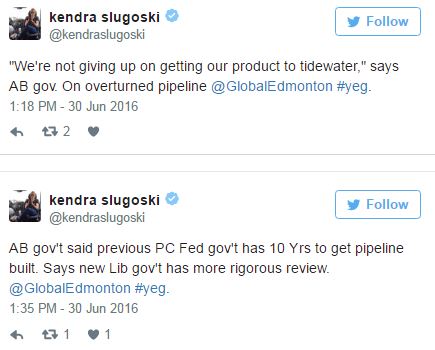
… The judgment is dated June 23 and has not been posted on the court’s website, but it was released today by JFK Law Corp., which represents a First Nation involved in the appeal.
Statement from Northern Gateway:
John Carruthers, president of Northern Gateway, said:
“Today the Federal Court of Appeal addressed important concerns regarding the Northern Gateway Pipeline. Though the court found that the JRP recommendation was acceptable and defensible on the facts and the law and is reasonable they concluded that further Crown consultation is required.
“While the matter is remitted to the federal government for their redetermination, Northern Gateway will consult with the Aboriginal Equity Partners and our commercial project proponents to determine our next steps.
“However, the Aboriginal Equity Partners and our commercial project proponents are fully committed to building this critical Canadian infrastructure project while at the same time protecting the environment and the traditional way of life of First Nations and Métis peoples and communities along the project route.”
Statement from Greenpeace Canada:
Mike Hudema, Climate and Energy Campaigner with Greenpeace Canada, said:
“Today’s decision is an important victory for First Nations, environmental groups, and all those who care about Indigenous Rights, environmental protection and community safety. The Northern Gateway pipeline – as well other proposed pipelines – must not go forward if Canada wants to uphold its international and continental climate engagements. The ball is now in the federal government’s court, which, we hope, will stop pushing pipelines, institute its promised tanker ban, and accelerate the transition towards the clean, renewable energy that our communities and our climate so desperately need.” [Emphasis added]
Northern Gateway pipeline approval overturned, Federal Court of Appeal finds Canada failed to consult with First Nations on pipeline project by Jason Proctor, June 30, 2016, CBC News
The Federal Court of Appeal has overturned approval of Enbridge’s controversial Northern Gateway project after finding Ottawa failed to properly consult the First Nations affected by the pipeline.
“We find that Canada offered only a brief, hurried and inadequate opportunity … to exchange and discuss information and to dialogue,” the ruling says.
“It would have taken Canada little time and little organizational effort to engage in meaningful dialogue on these and other subjects of prime importance to Aboriginal Peoples. But this did not happen.”
Constitutional requirement to consult
The majority ruling was signed by two of the three judges on the Appeal Court panel. Judge Michael Ryer wrote a dissenting opinion.
Pipeline opponents have called the decision “landmark.”
“At every turn you’re going, you are seeing nails in the coffin of the Enbridge project,” said Peter Lantin, president of the council of the Haida Nation, one of the parties that appealed.
“I don’t think there’s enough room for another nail in the coffin.” [Alberta can easily keep its greed, and that of multinationals, at home]
“First Nations, local communities, and environmental interests said no to Enbridge 12 years ago when it first proposed the project. And now that “no” has the backing of the courts,” said Ecojustice lawyer Barry Robinson.
“Between on-the-ground opposition and the federal government’s promises to keep B.C.’s North Coast tanker free and demonstrate climate leadership, this pipeline is never getting built.”
Northern Gateway president John Carruthers issued a statement saying Enbridge will consult with Aboriginal groups, but is still committed to the project and “protecting the environment and the traditional way of life of First Nations and Métis peoples and communities along the project route.”
The federal government gave the go-ahead to the Northern Gateway project after a National Energy Board joint review panel gave its approval subject to 209 conditions.
But the government was also supposed to meet a constitutional requirement to consult with Aboriginal Peoples following the release of that report.
According to the ruling, the project would significantly affect the B.C. First Nations who were parties to the appeal:
Gitxaala.
Haisla.
Gitga-at.
Kitasoo Xai’Xais Band Council.
Heiltsuk Tribal Council.
Nadleh Whut’en and Nak’azdli Whut’en.
Haida Nation.
Their traditional territory includes the waterway that would be used by tankers, the Kitimat terminal and some of the land the pipeline would cross.
‘Undisclosed, undiscussed and unconsidered’ [Like how the OGC, AER and Alberta and BC governments treat oil patch impacted citizens?]
The ruling noted that the Aboriginal groups generally availed themselves of the joint review panel hearings, submitting both oral and written testimony to the NEB.
But the release of the joint review panel report was only the third step in a five-part process before the permit to build the pipeline could be issued. In the fourth phase, the Crown was supposed to consult with Aboriginal Peoples “on any project-related concerns that were outside of the Joint Review Panel’s mandate.”
The Appeal Court ruling says the standard for consultation doesn’t have to be perfection, but rather “whether ‘reasonable efforts to inform and consult’ were made.”
The judges found the federal government had not met that standard.
“The inadequacies — more than just a handful and more than mere imperfections — left entire subjects of central interest to the affected First Nations, sometimes subjects affecting their subsistence and well-being, entirely ignored,” the ruling says.
“Many impacts of the project — some identified in the Report of the Joint Review Panel, some not — were left undisclosed, undiscussed and unconsidered.”
The appeal court also pointed out that this was not a case where the proponent of the project itself had failed to reach out to Aboriginal Peoples.
“Far from it,” the ruling says. “Once the pipeline corridor for the project was defined in 2005, Northern Gateway engaged with all Aboriginal groups, both First Nations and Métis, with communities located within 80 kilometres of the project corridor.”
A complicated case
In what the judges themselves described as a “complicated” case, the Appeal Court was also asked to consider the legal viability of the order in council which allows the government to issue a certificate for the project.
The court found the government is entitled to come to a decision by balancing the economic, cultural and environmental considerations affecting the project.
But because of the Aboriginal consultation, the panel quashed the approval of the pipeline.
In his dissenting opinion, Ryer said he found the government had adequately consulted with First Nations. He rejected the assertion that the pipeline would affect governance rights of asserted Aboriginal title.
The judge said he agreed with the Crown’s assertion that it had created an extensive consultation process through means which included the joint review panel and that many of the First Nations’ concerns were addressed in the NEB’s 209 recommendations.
The ruling says the government can now reconsider the submissions which are already on the public record in order to consider the concerns of First Nations or they can redo Aboriginal consultation. Either way, once the process is completed, the approval of the project will go back to the federal government for consideration. [Emphasis added. Will the Federal government appeal or consult? And why are Crowns across Canada, federally and provincially, loath to consult with First Nations on NEB projects and others?]
Appeal court overturns Ottawa’s approval of Northern Gateway pipeline by Shawn McCarthy and Jeff Lewis, June 30, 2016, The Globe and Mail
The Federal Court of Appeal has quashed the cabinet approval of Enbridge Inc.’s Northern Gateway oilsands pipeline, saying Ottawa failed in its duty to consult with First Nations along the route.
The court ruling is another major blow to the controversial project that was already facing daunting challenges – including meeting the National Energy Board’s 209 conditions, achieving agreement from local aboriginal communities, and confronting the Liberal government promise to impose a ban on crude tanker traffic in the waters off northern British Columbia.
The pipeline proposal received approval in 2014 from the cabinet of former prime minister Stephen Harper, but it has been mired in legal uncertainty ever since.
Eight First Nations, four environmental groups and one labour union launched the legal challenge.
In its decision, the panel noted the federal government has a duty to consult First Nations on projects that affect their traditional territory and to accommodate their concerns. But on the Northern gateway project, the former Conservative government “fell well short of the mark” in the execution of that duty, it said.
The Alberta-based oilsands industry – backed by the New Democratic Party government – argues it is crucial to obtain pipeline access to Canada’s coasts in order to access new markets and ensure the sector receives world prices for its crude.
“Today’s ruling shows what the people have been saying all along – this pipeline will never be built. This is a victory for our climate, our coast and for First Nation’s communities in determining their own future” said Sven Biggs, of Stand, an environmental group that was party to the challenge.
The judgment included a scathing indictment of the Harper government’s approach to consultations with First Nations over the Northern Gateway project, saying it appears the cabinet never considered whether it had fulfilled its duties to the aboriginal people before approving the pipeline.
It said the government conducted the consultations in a “brief, hurried and inadequate” manner.
“The inadequacies – more than just a handful and more than mere imperfections – left entire subjects of central interest to the affected First Nations, sometimes subjects affecting their subsistence and well-being, entirely ignored.”
The court said the Liberal government has a couple of options to revive the project, which would carry 500,000 barrels per day of crude to Kitimat, B.C., for export to Pacific markets. The government can send the matter back to the National Energy Board to review environmental matters, or it can simply initiate consultations with affected First Nations – the justices suggested a four-month timeline – to address their concerns and re-issue the permit.
However, Prime Minister Justin Trudeau has opposed the project, saying he did not support an oil pipeline running through British Columbia’s Great Bear Rainforest. Ottawa has signalled its intent to block its construction by imposing the tanker ban in the coastal waters that would provide access to the export terminal.
A few of the comments:
Milou2
Don’t blame this on the Courts. It is the result of the Harper government failing to follow the law and instead take shortcuts at every opportunity.
G S
First Nations don’t have a veto, but they do have a legal right to meaningful consultation.
If Harper wanted his government’s approval of the project to be legally binding, how hard would it have been to consult with the affected First Nations?
Rod Sheridan
Harper found it impossible to consult with anyone except himself.
Look at how fast CPP reform and the assisted dying law made progress once there was a federal government that would actually talk to people.
Able_Walker_
Are you talking about the Harper government, that couldn’t get into power without cheating in elections?
They were never held accountable for that.
Anyways, court decision is pretty common when it comes to Harper era initiatives that were challenged in court. They are usually found to be illegal or unconstitutional.
Chris in Ottawa
Once again, the Canadian Courts enforce the law and prevent another bad Harper decision from being actioned.
Gabriel Allon
Harper never thought laws applied to he and his ilk.
Guest_977
Every illegitimate project or law that Harper tried to ram through has been justly quashed by the courts. Did Harper achieve anything in his term as PM other than corruption and dividing the country?
mosestoo
ANOTHER smack down of the harper legacy…..every day we are being shown the type of fool harper has been…..
Appeal court overturns federal approval of Enbridge’s Northern Gateway pipeline by Thomson Reuters 2016 and Financial Post, June 30, 2016
Canada’s Federal Court of Appeal on Thursday released a decision overturning the approval of Enbridge Inc’s Northern Gateway pipeline, which would carry oil from the Alberta oil sands to a port in northern British Columbia for export.
The court ruled that the government had failed in its duty to consult with Aboriginal groups on the pipeline and sent the matter back to Prime Minister Justin Trudeau’s cabinet for a “prompt redetermination.”
“We conclude that Canada has not fulfilled its duty to consult,” according to the ruling.
… The court was especially concerned about developments that took place during Phase IV, which was after the Joint Review Panel had submitted its finding and Crown was expected engage in consultation and on any project-related concerns that were outside of the Joint Review Panel’s mandate.
… Vancouver-based JFK Law, which represented the Gitxaała Nation, said it’s a major victory for the First Nations, “whose rights and interests were ignored” in the project’s assessment.
“It is also a resounding win for the environmental and union organizations who were part of this litigation, and who sought to hold the government accountable for the process used to evaluate the significant environmental effects of industrial projects like this proposed pipeline,” the firm said in a blog.
Stand, formerly known as Forest Ethics said the ruling showed “what the people have been saying all along — this pipeline will never be built.”
The National Energy Board had approved Enbridge’s controversial Alberta-to-West-Coast pipeline in 2014 with more than 200 conditions, but the project is staunchly opposed by many indigenous nations and local communities.
In May, Enbridge had applied for a three-year extension to allow the company to resolve the challenges facing the Northern Gateway pipeline as its construction permit is set to expire by the end of the year. [Emphasis added]
An excellent example of one of the many energy pipeline risks to water:
Des citoyens de Saint-Lazare découvrent un tronçon de pipeline by Charles Côté, June 30, 2016, La Presse

Sylvie Rozon discovered Trans-Northern’s uncovered pipeline on her father’s land in a stream flowing into the Outaouais, upstream to Montreal’s main water intake. Trans-Northern took 2 days to show up, answers to written media questions only and have only an English speaking spokesperson by phone available.
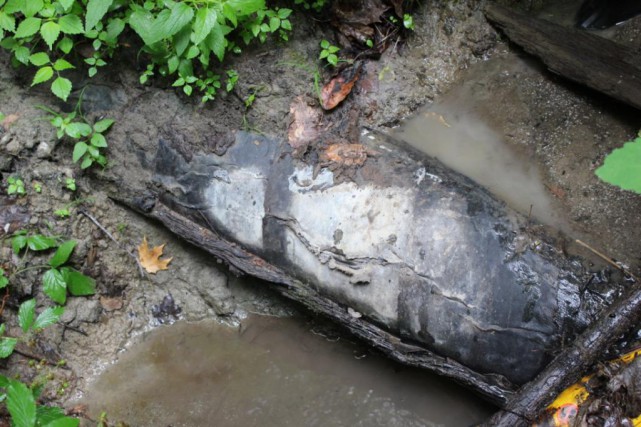
Photos by Sylvie Rozon, résidante de Saint-Lazare, en banlieue ouest de Montréal, a découvert lundi un tronçon du pipeline Trans-Nord exposé à l’air libre par l’érosion d’un ravin.
Sylvie Rozon, résidante de Saint-Lazare, en banlieue ouest de Montréal, a eu la surprise de découvrir lundi un tronçon du pipeline Trans-Nord exposé à l’air libre par l’érosion d’un ravin.
Elle se pose des questions sur la sécurité des pipelines, alors que l’industrie vante sa bonne performance environnementale dans son plus récent rapport.
« J’ai trouvé ce tronçon en marchant sur la terre de mon père, raconte Mme Rozon. Il y a deux semaines, Trans-Nord a effectué des travaux à environ 500 mètres de là. On s’est dit que ce serait bien de voir à quoi ça ressemblait. En marchant simplement, on est arrivés là. C’est tout un adon. Si je n’étais pas allée, ça leur aurait pris combien de temps avant de le découvrir ? »
Luc Falardeau était aussi de l’expédition. Il fait partie de l’organisme Citoyens au courant, qui s’inquiète des projets de pipelines et de la gestion des pipelines existants. « On voit le revêtement anticorrosion qui est endommagé », dit-il, en décrivant la partie de la conduite qui a été mise à nu.
«On a un questionnement sur la fréquence des inspections. Il y a plusieurs endroits où l’inspection aérienne est impossible et où l’inspection au sol est difficile à cause de la végétation.»
Luc Falardeau
Guy Coderre, un troisième citoyen, se questionne sur les risques pour l’eau potable. Le segment laissé à découvert à Saint-Lazare est dans un ruisseau qui se jette dans la rivière des Outaouais, 5 km plus loin, en amont de plusieurs prises d’eau de la région de Montréal. « On sait que dans le cas du déversement dans la rivière Chaudière, à Lac-Mégantic, les prises d’eau de Saint-Georges et de Lévis ont été fermées pendant 76 jours », dit-il.
Il rappelle que le pipeline Trans-Nord est à l’origine de trois fuites ces dernières années au Québec.
« PAS DE RISQUE », SELON TRANS-NORD
Les citoyens ont averti la Ville de Saint-Lazare, qui les a plutôt dirigés vers la société Trans-Nord. Cette dernière a fait savoir qu’elle a visité le site, hier, et que des mesures de sécurité seront mises en place à partir d’aujourd’hui.
L’entreprise a fait parvenir à La Presse une déclaration écrite. La conduite exposée « ne comporte pas de risque » et des travaux d’inspection, de réparation et de terrassement seront réalisés à partir d’aujourd’hui pour la protéger.
Trans-Nord affirme que des inspections se font régulièrement à pied le long de la conduite.
En dépit des inquiétudes des citoyens, l’industrie des pipelines vante sa performance pour l’année 2015. Au total, seulement 16 barils de pétrole ont été répandus au pays, sur 1,2 milliard de barils transportés. Le nombre d’incidents par 1000 kilomètres est à son plus bas depuis des années, et aucun « incident important » ne s’est produit.
Selon Jim Donihee, de l’Association canadienne des pipelines d’énergie, ce sont les programmes d’amélioration adoptés par l’industrie qui commencent à porter leurs fruits.
« Notre programme “Intégrité en premier” avance bien, dit-il. On s’attaque aux endroits où il y a des risques et on travaille aussi sur la culture de sécurité. »
Il remarque que les situations comme celles à Saint-Lazare peuvent se produire même avec les mesures d’inspection en place. « Quand on a de grosses averses, il y a des risques d’érosion, dit-il. Les entreprises doivent augmenter la fréquence des inspections dans les zones à risque. Dans ce cas-ci, il n’y a pas de fuite ou de rupture et il va y avoir une intervention très rapide. »
PIPELINE TRANS-NORD
Construit en 1952
Diamètre de 10 pouces (25 cm)
Relie Nanticoke, en Ontario, au secteur des raffineries à l’est de Montréal avec deux embranchements, un vers Ottawa et l’autre vers l’aéroport Trudeau.
Transporte des produits pétroliers raffinés tels l’essence, le diesel, le carburant d’aviation et le mazout.
Trois fuites
2003 : SAINT-CLET
25 000 litres de diesel dans un fossé
2010 : LAVAL
14 000 litres d’essence sur les berges de la rivière des Prairies
2010 : MONTRÉAL-EST
1500 litres de kérosène
[Emphasis added]

